Appendectomy and Family-Centered Care: A Nursing Case Study Analysis
VerifiedAdded on 2020/06/06
|7
|2578
|98
Case Study
AI Summary
This case study focuses on a 10-year-old girl named Anne who underwent an appendectomy and requires a 10-day hospital stay. It delves into the pathophysiology of acute appendicitis, including luminal obstruction, inflammation, and potential complications like perforation. The assignment highlights the role of nurses in providing appropriate care, particularly intravenous therapy and pain management via PCA, while also considering the patient's developmental stage through Piaget's theory of cognitive development and Bowlby's attachment theory. The essay emphasizes family-centered care, exploring the roles of parents and nurses in supporting Anne and addressing the impact of her hospitalization on her family, including potential financial and emotional challenges for her parents and siblings. The study concludes by underscoring the importance of pediatric nurses in providing comprehensive care, including emotional support and health education for both the child and her family.
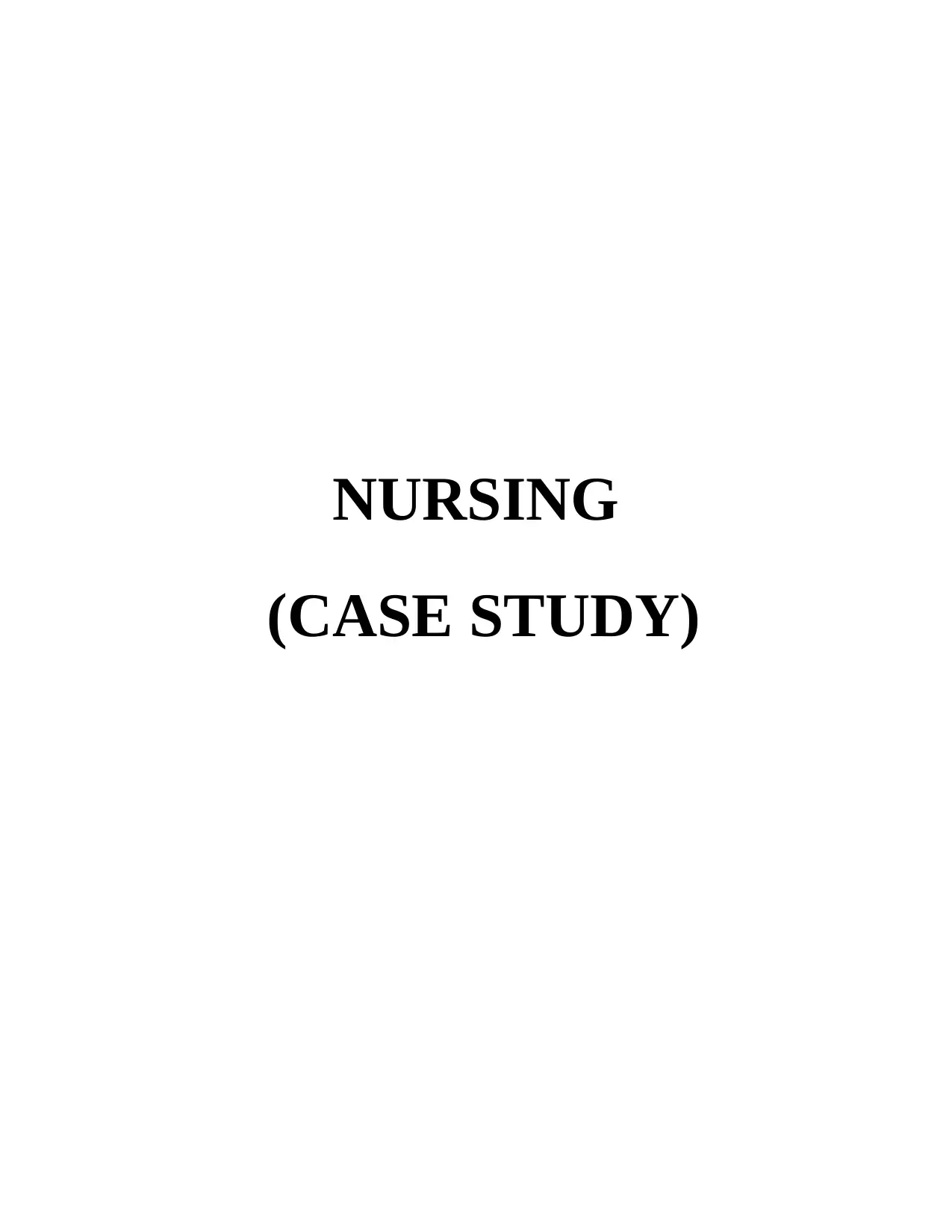
NURSING
(CASE STUDY)
(CASE STUDY)
Paraphrase This Document
Need a fresh take? Get an instant paraphrase of this document with our AI Paraphraser
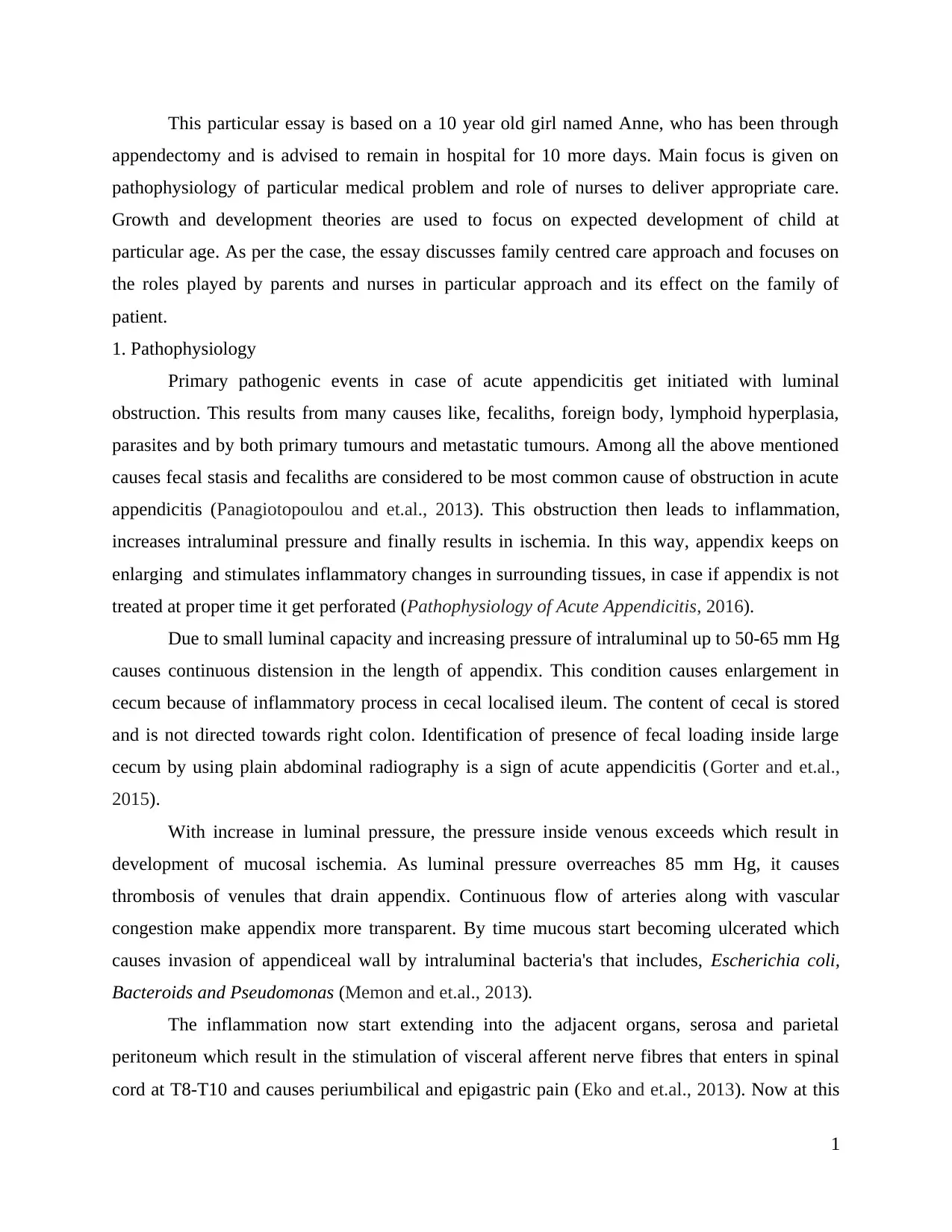
This particular essay is based on a 10 year old girl named Anne, who has been through
appendectomy and is advised to remain in hospital for 10 more days. Main focus is given on
pathophysiology of particular medical problem and role of nurses to deliver appropriate care.
Growth and development theories are used to focus on expected development of child at
particular age. As per the case, the essay discusses family centred care approach and focuses on
the roles played by parents and nurses in particular approach and its effect on the family of
patient.
1. Pathophysiology
Primary pathogenic events in case of acute appendicitis get initiated with luminal
obstruction. This results from many causes like, fecaliths, foreign body, lymphoid hyperplasia,
parasites and by both primary tumours and metastatic tumours. Among all the above mentioned
causes fecal stasis and fecaliths are considered to be most common cause of obstruction in acute
appendicitis (Panagiotopoulou and et.al., 2013). This obstruction then leads to inflammation,
increases intraluminal pressure and finally results in ischemia. In this way, appendix keeps on
enlarging and stimulates inflammatory changes in surrounding tissues, in case if appendix is not
treated at proper time it get perforated (Pathophysiology of Acute Appendicitis, 2016).
Due to small luminal capacity and increasing pressure of intraluminal up to 50-65 mm Hg
causes continuous distension in the length of appendix. This condition causes enlargement in
cecum because of inflammatory process in cecal localised ileum. The content of cecal is stored
and is not directed towards right colon. Identification of presence of fecal loading inside large
cecum by using plain abdominal radiography is a sign of acute appendicitis (Gorter and et.al.,
2015).
With increase in luminal pressure, the pressure inside venous exceeds which result in
development of mucosal ischemia. As luminal pressure overreaches 85 mm Hg, it causes
thrombosis of venules that drain appendix. Continuous flow of arteries along with vascular
congestion make appendix more transparent. By time mucous start becoming ulcerated which
causes invasion of appendiceal wall by intraluminal bacteria's that includes, Escherichia coli,
Bacteroids and Pseudomonas (Memon and et.al., 2013).
The inflammation now start extending into the adjacent organs, serosa and parietal
peritoneum which result in the stimulation of visceral afferent nerve fibres that enters in spinal
cord at T8-T10 and causes periumbilical and epigastric pain (Eko and et.al., 2013). Now at this
1
appendectomy and is advised to remain in hospital for 10 more days. Main focus is given on
pathophysiology of particular medical problem and role of nurses to deliver appropriate care.
Growth and development theories are used to focus on expected development of child at
particular age. As per the case, the essay discusses family centred care approach and focuses on
the roles played by parents and nurses in particular approach and its effect on the family of
patient.
1. Pathophysiology
Primary pathogenic events in case of acute appendicitis get initiated with luminal
obstruction. This results from many causes like, fecaliths, foreign body, lymphoid hyperplasia,
parasites and by both primary tumours and metastatic tumours. Among all the above mentioned
causes fecal stasis and fecaliths are considered to be most common cause of obstruction in acute
appendicitis (Panagiotopoulou and et.al., 2013). This obstruction then leads to inflammation,
increases intraluminal pressure and finally results in ischemia. In this way, appendix keeps on
enlarging and stimulates inflammatory changes in surrounding tissues, in case if appendix is not
treated at proper time it get perforated (Pathophysiology of Acute Appendicitis, 2016).
Due to small luminal capacity and increasing pressure of intraluminal up to 50-65 mm Hg
causes continuous distension in the length of appendix. This condition causes enlargement in
cecum because of inflammatory process in cecal localised ileum. The content of cecal is stored
and is not directed towards right colon. Identification of presence of fecal loading inside large
cecum by using plain abdominal radiography is a sign of acute appendicitis (Gorter and et.al.,
2015).
With increase in luminal pressure, the pressure inside venous exceeds which result in
development of mucosal ischemia. As luminal pressure overreaches 85 mm Hg, it causes
thrombosis of venules that drain appendix. Continuous flow of arteries along with vascular
congestion make appendix more transparent. By time mucous start becoming ulcerated which
causes invasion of appendiceal wall by intraluminal bacteria's that includes, Escherichia coli,
Bacteroids and Pseudomonas (Memon and et.al., 2013).
The inflammation now start extending into the adjacent organs, serosa and parietal
peritoneum which result in the stimulation of visceral afferent nerve fibres that enters in spinal
cord at T8-T10 and causes periumbilical and epigastric pain (Eko and et.al., 2013). Now at this
1
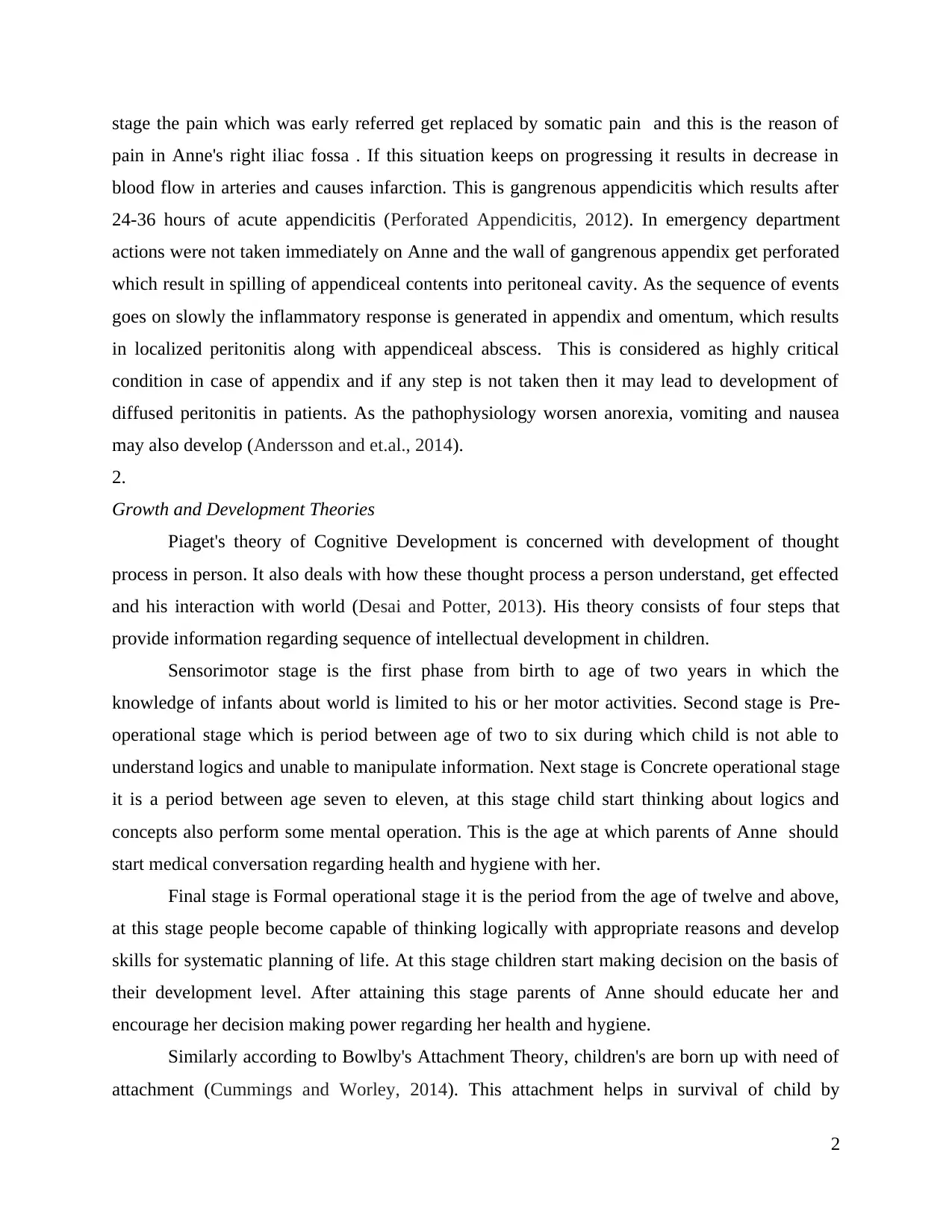
stage the pain which was early referred get replaced by somatic pain and this is the reason of
pain in Anne's right iliac fossa . If this situation keeps on progressing it results in decrease in
blood flow in arteries and causes infarction. This is gangrenous appendicitis which results after
24-36 hours of acute appendicitis (Perforated Appendicitis, 2012). In emergency department
actions were not taken immediately on Anne and the wall of gangrenous appendix get perforated
which result in spilling of appendiceal contents into peritoneal cavity. As the sequence of events
goes on slowly the inflammatory response is generated in appendix and omentum, which results
in localized peritonitis along with appendiceal abscess. This is considered as highly critical
condition in case of appendix and if any step is not taken then it may lead to development of
diffused peritonitis in patients. As the pathophysiology worsen anorexia, vomiting and nausea
may also develop (Andersson and et.al., 2014).
2.
Growth and Development Theories
Piaget's theory of Cognitive Development is concerned with development of thought
process in person. It also deals with how these thought process a person understand, get effected
and his interaction with world (Desai and Potter, 2013). His theory consists of four steps that
provide information regarding sequence of intellectual development in children.
Sensorimotor stage is the first phase from birth to age of two years in which the
knowledge of infants about world is limited to his or her motor activities. Second stage is Pre-
operational stage which is period between age of two to six during which child is not able to
understand logics and unable to manipulate information. Next stage is Concrete operational stage
it is a period between age seven to eleven, at this stage child start thinking about logics and
concepts also perform some mental operation. This is the age at which parents of Anne should
start medical conversation regarding health and hygiene with her.
Final stage is Formal operational stage it is the period from the age of twelve and above,
at this stage people become capable of thinking logically with appropriate reasons and develop
skills for systematic planning of life. At this stage children start making decision on the basis of
their development level. After attaining this stage parents of Anne should educate her and
encourage her decision making power regarding her health and hygiene.
Similarly according to Bowlby's Attachment Theory, children's are born up with need of
attachment (Cummings and Worley, 2014). This attachment helps in survival of child by
2
pain in Anne's right iliac fossa . If this situation keeps on progressing it results in decrease in
blood flow in arteries and causes infarction. This is gangrenous appendicitis which results after
24-36 hours of acute appendicitis (Perforated Appendicitis, 2012). In emergency department
actions were not taken immediately on Anne and the wall of gangrenous appendix get perforated
which result in spilling of appendiceal contents into peritoneal cavity. As the sequence of events
goes on slowly the inflammatory response is generated in appendix and omentum, which results
in localized peritonitis along with appendiceal abscess. This is considered as highly critical
condition in case of appendix and if any step is not taken then it may lead to development of
diffused peritonitis in patients. As the pathophysiology worsen anorexia, vomiting and nausea
may also develop (Andersson and et.al., 2014).
2.
Growth and Development Theories
Piaget's theory of Cognitive Development is concerned with development of thought
process in person. It also deals with how these thought process a person understand, get effected
and his interaction with world (Desai and Potter, 2013). His theory consists of four steps that
provide information regarding sequence of intellectual development in children.
Sensorimotor stage is the first phase from birth to age of two years in which the
knowledge of infants about world is limited to his or her motor activities. Second stage is Pre-
operational stage which is period between age of two to six during which child is not able to
understand logics and unable to manipulate information. Next stage is Concrete operational stage
it is a period between age seven to eleven, at this stage child start thinking about logics and
concepts also perform some mental operation. This is the age at which parents of Anne should
start medical conversation regarding health and hygiene with her.
Final stage is Formal operational stage it is the period from the age of twelve and above,
at this stage people become capable of thinking logically with appropriate reasons and develop
skills for systematic planning of life. At this stage children start making decision on the basis of
their development level. After attaining this stage parents of Anne should educate her and
encourage her decision making power regarding her health and hygiene.
Similarly according to Bowlby's Attachment Theory, children's are born up with need of
attachment (Cummings and Worley, 2014). This attachment helps in survival of child by
2
⊘ This is a preview!⊘
Do you want full access?
Subscribe today to unlock all pages.

Trusted by 1+ million students worldwide
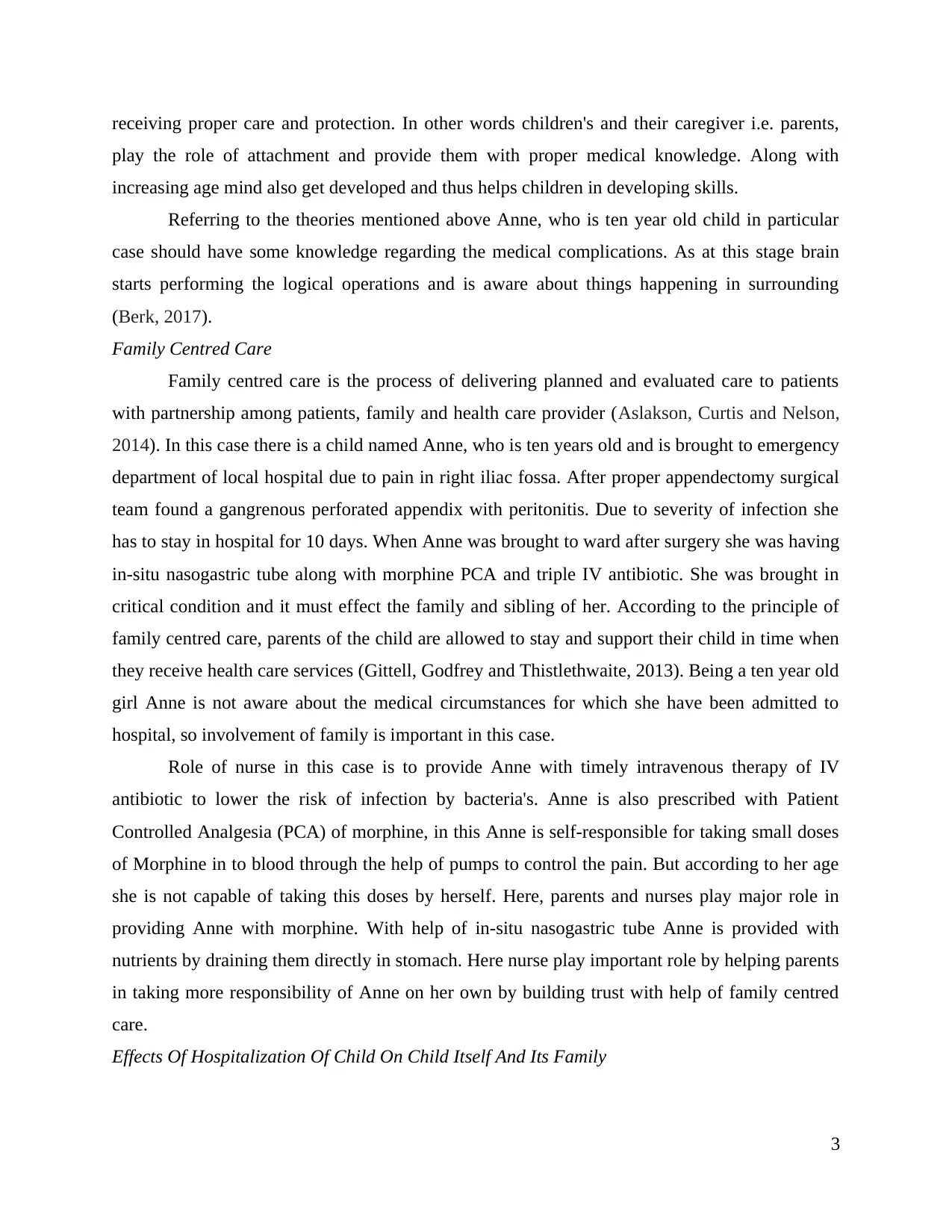
receiving proper care and protection. In other words children's and their caregiver i.e. parents,
play the role of attachment and provide them with proper medical knowledge. Along with
increasing age mind also get developed and thus helps children in developing skills.
Referring to the theories mentioned above Anne, who is ten year old child in particular
case should have some knowledge regarding the medical complications. As at this stage brain
starts performing the logical operations and is aware about things happening in surrounding
(Berk, 2017).
Family Centred Care
Family centred care is the process of delivering planned and evaluated care to patients
with partnership among patients, family and health care provider (Aslakson, Curtis and Nelson,
2014). In this case there is a child named Anne, who is ten years old and is brought to emergency
department of local hospital due to pain in right iliac fossa. After proper appendectomy surgical
team found a gangrenous perforated appendix with peritonitis. Due to severity of infection she
has to stay in hospital for 10 days. When Anne was brought to ward after surgery she was having
in-situ nasogastric tube along with morphine PCA and triple IV antibiotic. She was brought in
critical condition and it must effect the family and sibling of her. According to the principle of
family centred care, parents of the child are allowed to stay and support their child in time when
they receive health care services (Gittell, Godfrey and Thistlethwaite, 2013). Being a ten year old
girl Anne is not aware about the medical circumstances for which she have been admitted to
hospital, so involvement of family is important in this case.
Role of nurse in this case is to provide Anne with timely intravenous therapy of IV
antibiotic to lower the risk of infection by bacteria's. Anne is also prescribed with Patient
Controlled Analgesia (PCA) of morphine, in this Anne is self-responsible for taking small doses
of Morphine in to blood through the help of pumps to control the pain. But according to her age
she is not capable of taking this doses by herself. Here, parents and nurses play major role in
providing Anne with morphine. With help of in-situ nasogastric tube Anne is provided with
nutrients by draining them directly in stomach. Here nurse play important role by helping parents
in taking more responsibility of Anne on her own by building trust with help of family centred
care.
Effects Of Hospitalization Of Child On Child Itself And Its Family
3
play the role of attachment and provide them with proper medical knowledge. Along with
increasing age mind also get developed and thus helps children in developing skills.
Referring to the theories mentioned above Anne, who is ten year old child in particular
case should have some knowledge regarding the medical complications. As at this stage brain
starts performing the logical operations and is aware about things happening in surrounding
(Berk, 2017).
Family Centred Care
Family centred care is the process of delivering planned and evaluated care to patients
with partnership among patients, family and health care provider (Aslakson, Curtis and Nelson,
2014). In this case there is a child named Anne, who is ten years old and is brought to emergency
department of local hospital due to pain in right iliac fossa. After proper appendectomy surgical
team found a gangrenous perforated appendix with peritonitis. Due to severity of infection she
has to stay in hospital for 10 days. When Anne was brought to ward after surgery she was having
in-situ nasogastric tube along with morphine PCA and triple IV antibiotic. She was brought in
critical condition and it must effect the family and sibling of her. According to the principle of
family centred care, parents of the child are allowed to stay and support their child in time when
they receive health care services (Gittell, Godfrey and Thistlethwaite, 2013). Being a ten year old
girl Anne is not aware about the medical circumstances for which she have been admitted to
hospital, so involvement of family is important in this case.
Role of nurse in this case is to provide Anne with timely intravenous therapy of IV
antibiotic to lower the risk of infection by bacteria's. Anne is also prescribed with Patient
Controlled Analgesia (PCA) of morphine, in this Anne is self-responsible for taking small doses
of Morphine in to blood through the help of pumps to control the pain. But according to her age
she is not capable of taking this doses by herself. Here, parents and nurses play major role in
providing Anne with morphine. With help of in-situ nasogastric tube Anne is provided with
nutrients by draining them directly in stomach. Here nurse play important role by helping parents
in taking more responsibility of Anne on her own by building trust with help of family centred
care.
Effects Of Hospitalization Of Child On Child Itself And Its Family
3
Paraphrase This Document
Need a fresh take? Get an instant paraphrase of this document with our AI Paraphraser
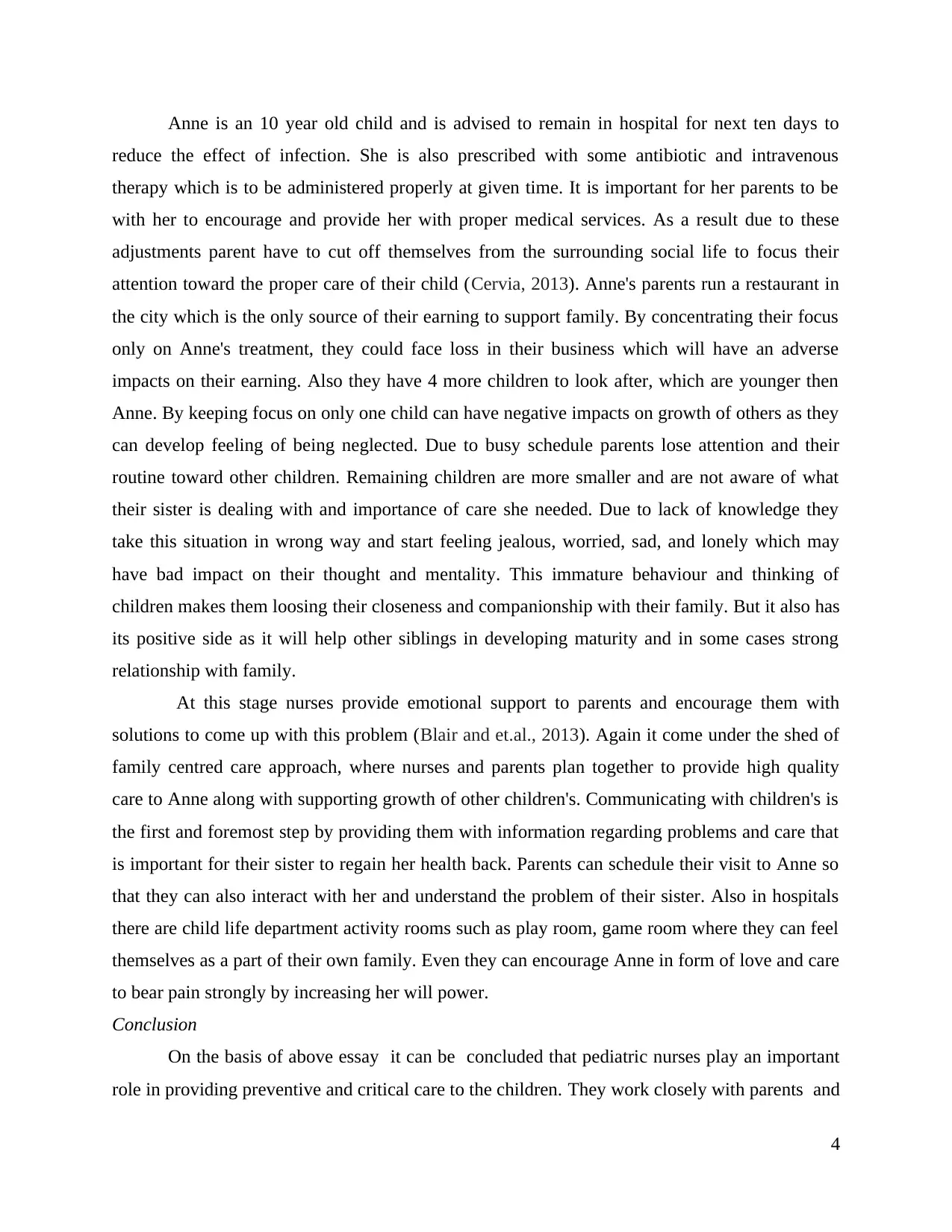
Anne is an 10 year old child and is advised to remain in hospital for next ten days to
reduce the effect of infection. She is also prescribed with some antibiotic and intravenous
therapy which is to be administered properly at given time. It is important for her parents to be
with her to encourage and provide her with proper medical services. As a result due to these
adjustments parent have to cut off themselves from the surrounding social life to focus their
attention toward the proper care of their child (Cervia, 2013). Anne's parents run a restaurant in
the city which is the only source of their earning to support family. By concentrating their focus
only on Anne's treatment, they could face loss in their business which will have an adverse
impacts on their earning. Also they have 4 more children to look after, which are younger then
Anne. By keeping focus on only one child can have negative impacts on growth of others as they
can develop feeling of being neglected. Due to busy schedule parents lose attention and their
routine toward other children. Remaining children are more smaller and are not aware of what
their sister is dealing with and importance of care she needed. Due to lack of knowledge they
take this situation in wrong way and start feeling jealous, worried, sad, and lonely which may
have bad impact on their thought and mentality. This immature behaviour and thinking of
children makes them loosing their closeness and companionship with their family. But it also has
its positive side as it will help other siblings in developing maturity and in some cases strong
relationship with family.
At this stage nurses provide emotional support to parents and encourage them with
solutions to come up with this problem (Blair and et.al., 2013). Again it come under the shed of
family centred care approach, where nurses and parents plan together to provide high quality
care to Anne along with supporting growth of other children's. Communicating with children's is
the first and foremost step by providing them with information regarding problems and care that
is important for their sister to regain her health back. Parents can schedule their visit to Anne so
that they can also interact with her and understand the problem of their sister. Also in hospitals
there are child life department activity rooms such as play room, game room where they can feel
themselves as a part of their own family. Even they can encourage Anne in form of love and care
to bear pain strongly by increasing her will power.
Conclusion
On the basis of above essay it can be concluded that pediatric nurses play an important
role in providing preventive and critical care to the children. They work closely with parents and
4
reduce the effect of infection. She is also prescribed with some antibiotic and intravenous
therapy which is to be administered properly at given time. It is important for her parents to be
with her to encourage and provide her with proper medical services. As a result due to these
adjustments parent have to cut off themselves from the surrounding social life to focus their
attention toward the proper care of their child (Cervia, 2013). Anne's parents run a restaurant in
the city which is the only source of their earning to support family. By concentrating their focus
only on Anne's treatment, they could face loss in their business which will have an adverse
impacts on their earning. Also they have 4 more children to look after, which are younger then
Anne. By keeping focus on only one child can have negative impacts on growth of others as they
can develop feeling of being neglected. Due to busy schedule parents lose attention and their
routine toward other children. Remaining children are more smaller and are not aware of what
their sister is dealing with and importance of care she needed. Due to lack of knowledge they
take this situation in wrong way and start feeling jealous, worried, sad, and lonely which may
have bad impact on their thought and mentality. This immature behaviour and thinking of
children makes them loosing their closeness and companionship with their family. But it also has
its positive side as it will help other siblings in developing maturity and in some cases strong
relationship with family.
At this stage nurses provide emotional support to parents and encourage them with
solutions to come up with this problem (Blair and et.al., 2013). Again it come under the shed of
family centred care approach, where nurses and parents plan together to provide high quality
care to Anne along with supporting growth of other children's. Communicating with children's is
the first and foremost step by providing them with information regarding problems and care that
is important for their sister to regain her health back. Parents can schedule their visit to Anne so
that they can also interact with her and understand the problem of their sister. Also in hospitals
there are child life department activity rooms such as play room, game room where they can feel
themselves as a part of their own family. Even they can encourage Anne in form of love and care
to bear pain strongly by increasing her will power.
Conclusion
On the basis of above essay it can be concluded that pediatric nurses play an important
role in providing preventive and critical care to the children. They work closely with parents and
4
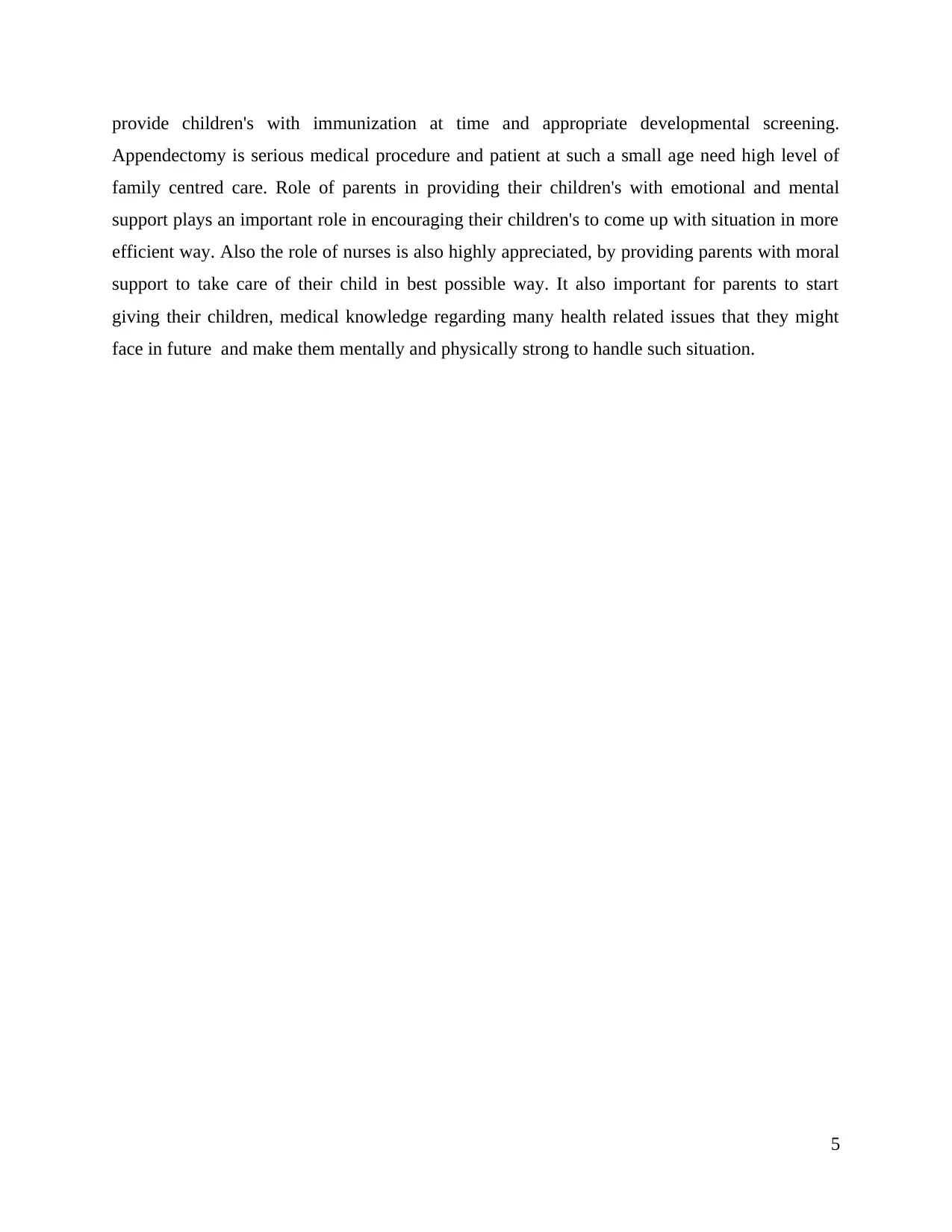
provide children's with immunization at time and appropriate developmental screening.
Appendectomy is serious medical procedure and patient at such a small age need high level of
family centred care. Role of parents in providing their children's with emotional and mental
support plays an important role in encouraging their children's to come up with situation in more
efficient way. Also the role of nurses is also highly appreciated, by providing parents with moral
support to take care of their child in best possible way. It also important for parents to start
giving their children, medical knowledge regarding many health related issues that they might
face in future and make them mentally and physically strong to handle such situation.
5
Appendectomy is serious medical procedure and patient at such a small age need high level of
family centred care. Role of parents in providing their children's with emotional and mental
support plays an important role in encouraging their children's to come up with situation in more
efficient way. Also the role of nurses is also highly appreciated, by providing parents with moral
support to take care of their child in best possible way. It also important for parents to start
giving their children, medical knowledge regarding many health related issues that they might
face in future and make them mentally and physically strong to handle such situation.
5
⊘ This is a preview!⊘
Do you want full access?
Subscribe today to unlock all pages.

Trusted by 1+ million students worldwide
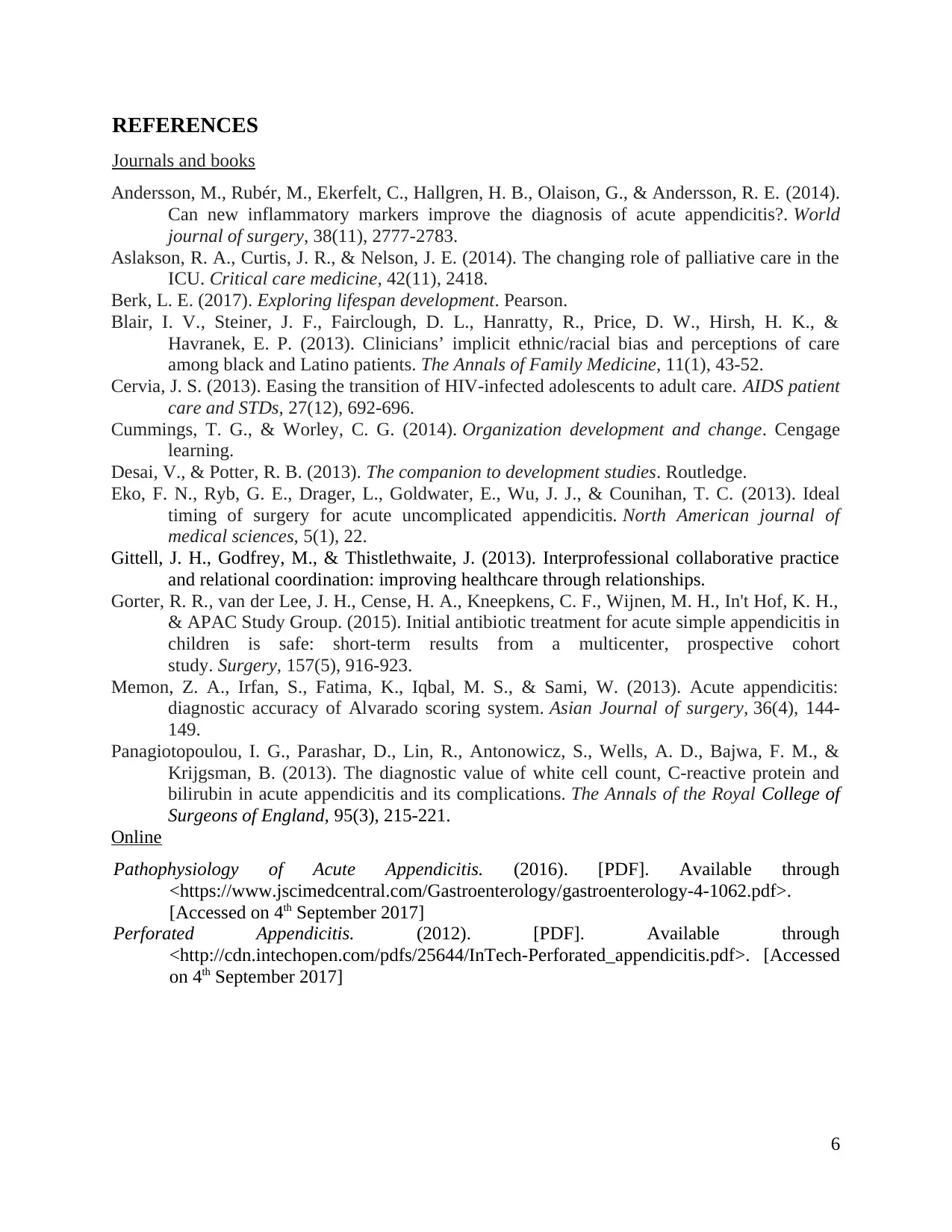
REFERENCES
Journals and books
Andersson, M., Rubér, M., Ekerfelt, C., Hallgren, H. B., Olaison, G., & Andersson, R. E. (2014).
Can new inflammatory markers improve the diagnosis of acute appendicitis?. World
journal of surgery, 38(11), 2777-2783.
Aslakson, R. A., Curtis, J. R., & Nelson, J. E. (2014). The changing role of palliative care in the
ICU. Critical care medicine, 42(11), 2418.
Berk, L. E. (2017). Exploring lifespan development. Pearson.
Blair, I. V., Steiner, J. F., Fairclough, D. L., Hanratty, R., Price, D. W., Hirsh, H. K., &
Havranek, E. P. (2013). Clinicians’ implicit ethnic/racial bias and perceptions of care
among black and Latino patients. The Annals of Family Medicine, 11(1), 43-52.
Cervia, J. S. (2013). Easing the transition of HIV-infected adolescents to adult care. AIDS patient
care and STDs, 27(12), 692-696.
Cummings, T. G., & Worley, C. G. (2014). Organization development and change. Cengage
learning.
Desai, V., & Potter, R. B. (2013). The companion to development studies. Routledge.
Eko, F. N., Ryb, G. E., Drager, L., Goldwater, E., Wu, J. J., & Counihan, T. C. (2013). Ideal
timing of surgery for acute uncomplicated appendicitis. North American journal of
medical sciences, 5(1), 22.
Gittell, J. H., Godfrey, M., & Thistlethwaite, J. (2013). Interprofessional collaborative practice
and relational coordination: improving healthcare through relationships.
Gorter, R. R., van der Lee, J. H., Cense, H. A., Kneepkens, C. F., Wijnen, M. H., In't Hof, K. H.,
& APAC Study Group. (2015). Initial antibiotic treatment for acute simple appendicitis in
children is safe: short-term results from a multicenter, prospective cohort
study. Surgery, 157(5), 916-923.
Memon, Z. A., Irfan, S., Fatima, K., Iqbal, M. S., & Sami, W. (2013). Acute appendicitis:
diagnostic accuracy of Alvarado scoring system. Asian Journal of surgery, 36(4), 144-
149.
Panagiotopoulou, I. G., Parashar, D., Lin, R., Antonowicz, S., Wells, A. D., Bajwa, F. M., &
Krijgsman, B. (2013). The diagnostic value of white cell count, C-reactive protein and
bilirubin in acute appendicitis and its complications. The Annals of the Royal College of
Surgeons of England, 95(3), 215-221.
Online
Pathophysiology of Acute Appendicitis. (2016). [PDF]. Available through
<https://www.jscimedcentral.com/Gastroenterology/gastroenterology-4-1062.pdf>.
[Accessed on 4th September 2017]
Perforated Appendicitis. (2012). [PDF]. Available through
<http://cdn.intechopen.com/pdfs/25644/InTech-Perforated_appendicitis.pdf>. [Accessed
on 4th September 2017]
6
Journals and books
Andersson, M., Rubér, M., Ekerfelt, C., Hallgren, H. B., Olaison, G., & Andersson, R. E. (2014).
Can new inflammatory markers improve the diagnosis of acute appendicitis?. World
journal of surgery, 38(11), 2777-2783.
Aslakson, R. A., Curtis, J. R., & Nelson, J. E. (2014). The changing role of palliative care in the
ICU. Critical care medicine, 42(11), 2418.
Berk, L. E. (2017). Exploring lifespan development. Pearson.
Blair, I. V., Steiner, J. F., Fairclough, D. L., Hanratty, R., Price, D. W., Hirsh, H. K., &
Havranek, E. P. (2013). Clinicians’ implicit ethnic/racial bias and perceptions of care
among black and Latino patients. The Annals of Family Medicine, 11(1), 43-52.
Cervia, J. S. (2013). Easing the transition of HIV-infected adolescents to adult care. AIDS patient
care and STDs, 27(12), 692-696.
Cummings, T. G., & Worley, C. G. (2014). Organization development and change. Cengage
learning.
Desai, V., & Potter, R. B. (2013). The companion to development studies. Routledge.
Eko, F. N., Ryb, G. E., Drager, L., Goldwater, E., Wu, J. J., & Counihan, T. C. (2013). Ideal
timing of surgery for acute uncomplicated appendicitis. North American journal of
medical sciences, 5(1), 22.
Gittell, J. H., Godfrey, M., & Thistlethwaite, J. (2013). Interprofessional collaborative practice
and relational coordination: improving healthcare through relationships.
Gorter, R. R., van der Lee, J. H., Cense, H. A., Kneepkens, C. F., Wijnen, M. H., In't Hof, K. H.,
& APAC Study Group. (2015). Initial antibiotic treatment for acute simple appendicitis in
children is safe: short-term results from a multicenter, prospective cohort
study. Surgery, 157(5), 916-923.
Memon, Z. A., Irfan, S., Fatima, K., Iqbal, M. S., & Sami, W. (2013). Acute appendicitis:
diagnostic accuracy of Alvarado scoring system. Asian Journal of surgery, 36(4), 144-
149.
Panagiotopoulou, I. G., Parashar, D., Lin, R., Antonowicz, S., Wells, A. D., Bajwa, F. M., &
Krijgsman, B. (2013). The diagnostic value of white cell count, C-reactive protein and
bilirubin in acute appendicitis and its complications. The Annals of the Royal College of
Surgeons of England, 95(3), 215-221.
Online
Pathophysiology of Acute Appendicitis. (2016). [PDF]. Available through
<https://www.jscimedcentral.com/Gastroenterology/gastroenterology-4-1062.pdf>.
[Accessed on 4th September 2017]
Perforated Appendicitis. (2012). [PDF]. Available through
<http://cdn.intechopen.com/pdfs/25644/InTech-Perforated_appendicitis.pdf>. [Accessed
on 4th September 2017]
6
1 out of 7
Related Documents
Your All-in-One AI-Powered Toolkit for Academic Success.
+13062052269
info@desklib.com
Available 24*7 on WhatsApp / Email
![[object Object]](/_next/static/media/star-bottom.7253800d.svg)
Unlock your academic potential
Copyright © 2020–2025 A2Z Services. All Rights Reserved. Developed and managed by ZUCOL.





